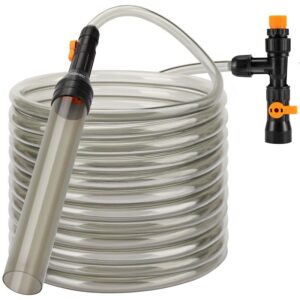For fish keeping in aquariums, maintaining great water conditions is an essential part. And pH level is one indicator of water condition. Fish may get sick or even die if the pH level in your tank is unsuitable for them. So, let’s explore further and understand how to control pH balance in aquariums.
Content Table
pH Balance
What does pH stand for? The pH is an indicator to measure the level of acid or alkali in the aquarium water, ranging from 0 to 14. A level below 7 means acid, a level of 7 indicates neutrality and a level above 7 shows alkali. And pH balance stands for a pH level around 7. Generally, fish feces make the water high in acid level, while gravel, shells, and corals or calcium and magnesium in the water cause alkaline water.
So, is it necessary to keep a balanced pH in your tank? The definitive and brief answer is yes. A balanced pH level is essential for fish tanks. It reduces stress because of water fluctuation, which would weaken the immune system and pose threats to fish health. Once your fish suffer from imbalanced pH, they will behave abnormally. For example, jumping out of fish tanks, gasping for air on the water’s surface, and body color fading.

Control the pH in Aquariums
Maintaining a constant pH level is critically crucial because pH fluctuation is detrimental to fish. Also, it is recommended to test the pH regularly. For instance, once each week or when you change aquarium water. A 7-in-1 aquarium test strip can monitor seven crucial water parameters in freshwater and saltwater aquariums. And it is easy to use. Just dip the strip into the aquarium water for 2 seconds, then take it out and wait for 30 seconds before comparing the color of the strip to the test strip reading chart.
To keep a stable and suitable pH level, this segment will share four ways to control the pH in aquariums.
Control the pH naturally
It is the most effective way to control the pH in slightly alkaline or acidic water. However, controlling the pH naturally is a long-term remedy and is less harmful to fish. Just add something that can slowly release acid or alkaline elements, like wood and coral sand. While some can also make your tank more aesthetic. Next, we will list something that can slowly release acid or alkaline elements.
- Something that can release acid elements: wood, Indian almond leaves, acid bacterial ring, etc.
- Something that can release alkaline elements: coral sand, coral stone, shell, seiryu stone, etc.
Control the pH chemically
It is feasible to control the pH chemically by adding a pH-regulating agent. The pH regulating agents, including alkali regulating agents, acid regulating agents, plus acid and alkali buffers, are available in aquarium stores. Generally, you can do pH control quickly in this way. Nonetheless, fast pH changes would be a threat to fish health. Thus, you should pay attention to the quantity of the pH regulating agent. The pH fluctuation should never be over plus or minus 0.2 each time.
Control the pH by softening the water
While controlling the pH naturally is effective in slightly alkaline or acidic water, you can treat the hard and alkaline water by softening it. You can change the water with lower hardness water, like pure water and distilled water. Also, adding soft water resin to filter media is another option.

Control the pH by adjusting the pets or substances in your tank
It is feasible to control the pH by decreasing fish density, reducing feeding amount, cleaning or replacing filter media, etc. By doing so, the amount of acid in the water will be decreased.
In a word, controlling the pH naturally is the best method to deal with slightly acidic or alkaline water. On the contrary, facing hard and alkaline water, it is recommended to soften the water to adjust the pH level. As for the other two ways, they should be your last choice. Because controlling the pH chemically would be more or less damage to your fish. And another way is less effective.
pH Controller with Dosing Pump
As we have mentioned in the last part, you can control the pH chemically by adding a pH-regulating agent. In this case, a dosing pump will help you a lot. A dosing pump can add solutions automatically timing and quantitatively. Just add the pH regulating agent to the pump, and then set the time and amount. The pump will add the agent to your tank automatically.
Sounds not bad, right? Exactly, the dosing pump will help you out when you are not at home, the fish tank is too high, memory confusion because of various liquids, etc. A dosing pump can meet the various needs of different users and aquarists. Also, an LCD and buttons make it easy to operate.
In Closing
To conclude, consistent and balanced pH is vital for aquariums. To minimize the damage to your fish, it is better to control the pH naturally by adding something that can slowly release acid or alkaline elements. Aside from all mentioned above, if you want to know more about how to check the pH before controlling it, you can go to How to Check pH in Aquarium Water.
That’s all for today. For more additional ideas about controlling pH balance in aquariums, welcome to share with us in the comment. We are happy to receive your sharing. Finally, thanks for taking the time, and we hope this article helps.


Leave a comment